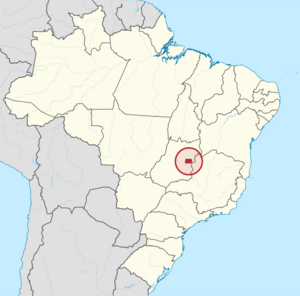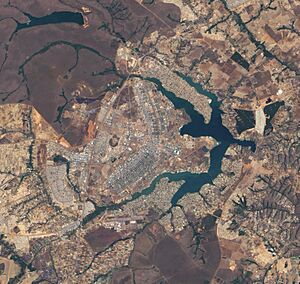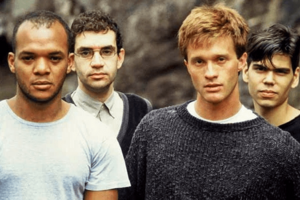History of Brasília facts for kids
Brasília, the capital city of Brazil, is located in the nation’s Federal District. Its story began long ago, even before it was built, with the native people who lived there. People first suggested moving Brazil's capital in the late 1700s. After many plans and attempts, the city was officially opened on April 21, 1960. It took only four years to build! Since then, Brasília has grown a lot. It has also faced challenges, but it has become an important place for music, art, and books.
Contents
Early History of Brasília
The land where Brasília now stands, in the State of Goias, was home to Indigenous people for a long time. This area was also important during the time when Brazil was a Portuguese colony. The State of Goias got its name from the Goia people. They lived in the center of the region. In the 1600s and 1700s, European settlers moved into their lands. This led to the Goia people becoming part of the new society, and their numbers decreased.
Brasília was built on a flat, grassy area called the savannah. There wasn't a big city there before. However, some important towns were nearby. For example, Luziânia, once called Santa Luzia, was founded in the 1740s. It became a successful town because of mining.
Planning the New Capital
The idea of moving Brazil's capital from Rio de Janeiro first came up in 1798. This idea came from a group called the Inconfidência Mineira. They wanted Brazil to be independent from Portugal. Their leader, Joaquim José da Silva Xavier, known as Tiradentes, planned a new capital in São João del-Rei. But Tiradentes was executed on April 21, 1792. This stopped the movement for a new capital for a long time.

Finding the Right Spot
In 1822, a Brazilian leader named José Bonifácio de Andrada e Silva wrote a plan. He said Brazil needed a new capital in the middle of the country. He suggested a spot in the state of Goias. Even though his ideas were similar to where Brasília is now, his plans didn't happen. Many other plans for a new capital also failed during Brazil's time as an Empire.
Things changed when Brazil became a republic in 1889. The new constitution (Brazil's main set of laws) said the capital should move inland. This was to help spread economic and social growth away from Rio de Janeiro. In 1892, a group led by Luís Cruls drew the first rough map for a new federal district. Later, in 1955, another group led by José Pessoa Cavalcanti de Albuquerque made the area smaller. They chose a 5,850 square kilometer area for the new capital. This is mostly the same size today. These plans were also mentioned in laws in 1922 and the constitution of 1946. Finally, the building of Brasília began under President Juscelino Kubitschek.
Building Brasília
Building Brasília was a big part of President Kubitschek’s plan called “Fifty Years in Five.” This plan aimed to make Brazil grow quickly in just five years. It focused on building new factories and cities across the country. The goal was to boost the economy and help cities like São Paulo and Rio de Janeiro by moving the capital inland.
Lúcio Costa became the main city planner in 1957. His design for the city was chosen. He worked with Oscar Niemeyer, a famous architect, and Roberto Burle Marx, a landscape designer. The first building finished was the Alvorada Palace, which is the official home for Brazil's President. After that, many other important government buildings were built. Construction then expanded to include offices, airports, and a huge network of roads. These roads connected Brasília to other major cities in Brazil. Along these roads, motels and warehouses were built.
The buildings in Brasília had a modern and futuristic style. Niemeyer was especially known for this. The city was designed to hold 500,000 people, a goal reached by 1970. The entire construction took only 41 months, from 1956 to April 21, 1960.

The company in charge of building Brasília was called NOVACAP. This name means 'New Capital'. Its main office was near the first construction site. This area later became known as Velhacap, or 'Old Capital'. Many other work camps appeared during construction. This was because many workers came from all over Brazil and other countries. They were drawn by the excitement and publicity around the new city. Nearby Velhacap was Candangolândia, and other small settlements grew in areas not covered by the main city plan. Many of these camps became communities. Workers lived in barracks and ate in shared dining halls. These communities later grew into the many smaller cities around Brasília today. Candangolândia is now an official administrative region.
Cost of Construction
Building Brasília was very expensive. President Café Filho estimated it cost about 1.5 billion US dollars (in 1954 money). Later governments were not sure of the exact cost. But it is generally thought to be one of the most expensive building projects ever. The high cost meant that taxes from all over the country went into building the city. This created a divide between city and country areas around Brasília. Many people from rural areas moved to the city for jobs. This led to a big increase in population. Today, 27 smaller cities, called satellite cities, have grown around Brasília. Many people who work in the city but earn less money live in these outer areas and travel to work.
The huge spending on Brasília also affected Brazil's economy. After 1946, Brazil's economy grew by making more goods at home instead of buying them from other countries. This needed a lot of money from other countries. Building Brasília made Brazil's national debt much worse. This led to higher prices (inflation) and slower economic growth. The lack of money for the city's construction was a problem for many years. Some people even say it helped cause very high inflation and a recession in the 1980s. President Kubitschek's "Fifty Years in Five" plan was criticized. Many people said it caused "fifty years’ inflation in five."
Social Impact of Brasília
Brasília became a symbol of national pride during and after its construction. People were very proud of its unique buildings. Dr. Steffen Lehmann, a university expert, said that Brasília was seen as "a modern utopia." This meant it was a perfect, futuristic city that showed hope for the future. This led to poems like "Ode to Brasília" by Alberto Bonfim, which praised the city's bold design. The city was built in the middle of the country to bring people closer to their government. This was meant to create a stronger national identity.
Early Years of Brasília
Cultural Growth
The University of Brasília officially opened in 1962. It was founded by Darcy Ribeiro, an expert on people and cultures, and Anísio Teixeira, an educator. Oscar Niemeyer designed the main university building, which was finished in 1971. The university aimed to "renew the methods of learning and to teach towards the future." It greatly helped the city's cultural growth and focus on the arts. In 1962, the Central Institute of the Arts opened. This brought more art teachers and experts to Brasília.
Around this time, the first books and poems from Brasília were published. The first collections of poems and stories, Poetas de Brasília and Contistas de Brasília, came out in 1962 and 1964. In 1965, the first 'Brasília Festival of Brazilian Film' was held. Today, it is one of Brazil's oldest and largest film festivals.

Political Changes
Brazil went through big changes starting in 1964. A military coup (when the military takes control of the government) removed President João Goulart. This happened because of economic and social problems. Goulart's policies were criticized as prices rose by almost 80% each year. Much of this was due to the huge spending on Brasília under President Kubitschek. The coup happened in Brasília. This greatly damaged the city's image as a symbol of hope and the future.
Brazil began to become a democracy again in the 1980s. A new constitution was written in 1988. This new constitution gave the Federal District, where Brasília is, more political freedom. It became less directly controlled by the national government. The constitution says the Federal District has the same rights as other states and municipalities. It can elect its own Governor. But it cannot be divided into smaller municipalities. So, the district is unique because it is both like a state and a municipality at the same time.
Brasília Today
Since the end of military rule in the 1980s, Brasília has become a center for culture, especially music. Many rock, punk, and grunge bands formed there. They started releasing music more easily in the new, freer cultural environment. These bands were inspired by similar music movements in the US and UK. Legião Urbana was one of the most famous groups. They released their first album in 1985. They were recognized by Rolling Stone magazine for their song, 'Que país é este?' and their lead singer Renato Russo. These bands helped change Brasília's image. It started to be known more for its arts than for its complicated political past.
See also
- Timeline of Brasília
- History of the city of São Paulo



